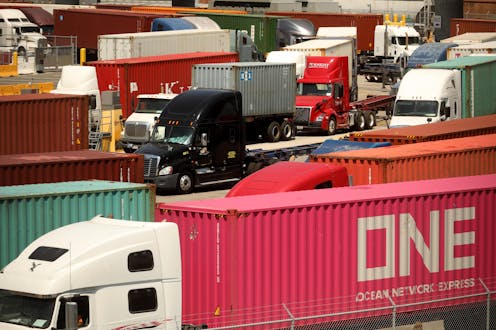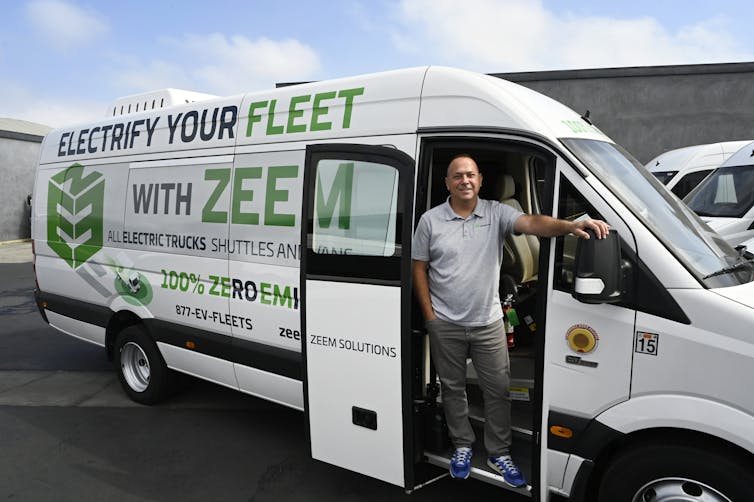Beyond passenger cars and pickups: 5 questions answered about electrifying trucks
As California goes on regulating air pollution, other states often follow – including the Golden State’s ambitious goals for cleaning up emissions from trucking.

As part of its effort to reduce air pollution and cut greenhouse gas emissions that contribute to climate change, California is pursuing aggressive policies to promote clean trucks. The state already requires that by 2035, all new cars and other light-duty vehicles sold in the state must be zero emission. Its powerful Air Resources Board has adopted rules requiring that most trucks be zero emission by 2035, and is now proposing that all trucks sold by 2040 must be zero emission. The Conversation asked a panel of transportation experts from the University of California, Davis what’s involved in such a rapid transition.
1. Why is California targeting medium- and heavy-duty trucks?
Although diesel engines are valuable for moving heavy loads, they also are major polluters. Diesel trucks account for one-fourth of greenhouse gas emissions and about half of conventional air pollution from transportation in U.S. cities.
Pollutants in diesel exhaust include nitrogen oxides, fine particulates and numerous cancer-causing compounds. Since many disadvantaged communities are located near highways and industrial centers, their residents are especially affected by diesel truck pollution. Two regions in California – the Central Valley and Los Angeles-Long Beach – have some of the dirtiest air in the U.S., so the state has placed particular emphasis on cutting diesel use.
2. Are zero-emission trucks ready to go?
To a degree, yes. Some new models, mainly powered by batteries but some by hydrogen fuel cells, are available on the market, and more are being announced almost daily.
But the production volumes are still small, and there are many variations of truck models needed for very diverse applications, from delivering mail locally and plowing snow to hauling goods cross-country. Many of these needs cannot be met with currently offered zero-emission trucks.
Another hurdle is that new electric truck models have higher purchase prices than comparable diesel trucks. However, as the market for zero-emission trucks grows, economies of scale should bring these costs down significantly. We already see this happening with zero-emission cars and light-duty trucks.
The total cost of ownership for zero-emission trucks, which includes the purchase price, fuel costs and maintenance, is already competitive in some applications with conventional diesel trucks. One example is trucks used for local goods delivery by companies like Amazon, UPS and FedEx. This stage is also known as last-mile delivery – getting a product to a buyer’s door.
These trucks are typically driven less than 150 miles per day, so they don’t need large battery packs. Their lower energy costs and reduced maintenance needs often offset their higher purchase costs, so owners save money on them over time.
Our studies indicate that by 2025 and especially by 2030, many applications for battery trucks, and perhaps hydrogen fuel cell trucks, will have competitive or even lower total costs of ownership than comparable diesel trucks. That’s especially true because of California subsidies and incentives, such as the Hybrid and Zero-Emission Truck and Bus Voucher Incentive Project, which reduces the cost of new electric trucks and buses. And the state’s Low Carbon Fuel Standard greatly reduces the cost of low-carbon fuels and electricity for truck and bus fleets.

The market in California is already reacting to these policy signals and is developing quickly. In the past year, there has been a large increase in sales of last-mile electric delivery trucks, and companies have stepped up their pledges to procure such vehicles.
Over 150 zero-emission truck models are commercially available and eligible for state incentive funding. They range from large pickup trucks to heavy-duty tractor units for tractor-trailer combinations.
3. Is there enough charging infrastructure to support all these vehicles?
Providing near-zero-carbon electricity for EVs and hydrogen for fuel cells, and expanding charging and hydrogen refueling infrastructure, is just as important as getting zero-emission trucks on the roads.
Fleet owners will need to install chargers that can charge their battery-powered trucks overnight, or sometimes during the day. These stations may require so much power that utilities will need to install additional hardware to bring electricity from the grid to the stations to meet potentially high demands at certain times.
Fuel cell trucks will require hydrogen stations installed either at fleet depots or public locations. These will allow fast refueling without high instantaneous demands on the system. But producing the hydrogen will require electricity, which will put an additional burden on the electric system.
Presently there are few public or private charging or hydrogen stations for truck fleets in California. But the California Public Utility Commission has allowed utilities to charge their customers to install a significant number of stations throughout the state. And the U.S. Department of Energy recently allocated $8 billion for construction of hydrogen hubs – networks for producing, processing, storing and delivering clean hydrogen – across the country.
Despite these efforts, the rollout of charging and hydrogen infrastructure will likely slow the transition to zero-emission trucks, especially long-haul trucks.
4. Who would be affected by a diesel truck ban?
California’s rules will affect both truck manufacturers and truck users. The state’s Advanced Clean Trucks rule, adopted in 2020, requires the sale of increasing percentages of zero emission trucks starting in 2024. By 2035, 40% to 75% of all trucks, depending on the truck type, must be zero emission.
A new proposal scheduled for adoption in early 2023, the Advanced Clean Fleets rule, would require fleets with over 50 trucks to purchase an increasing number of zero-emission trucks over time, with the requirement that all truck sales and purchases be zero emission by 2040.
These two policies would work together. The Advanced Clean Trucks rule ensures that zero-emission trucks will become available to fleets, and the Advanced Clean Fleets rule would give truck manufacturers confidence that the zero-emission trucks they produce will find buyers.
These two rules are the most ambitious in the world in accelerating a transition to zero-emission trucks.
5. Are other states emulating California?
Yes, there is strong interest in many other states in electrifying trucking. Oregon, Washington, New York, New Jersey and Massachusetts have already adopted the Advanced Clean Trucks rule, and others are in the process of doing so. Seventeen states and the District of Columbia have agreed to work together to foster a self-sustaining market for medium- and heavy-duty vehicles.
We expect that transitioning to zero-emission truck fleets will require strong policy support at least until the 2030s and perhaps longer. The transition should become self-sufficient in most cases as production scales up and fleets adapt their operations, resulting in lower costs. This could be soon, especially with medium-duty trucks.
Converting large long-haul trucks will be especially challenging because they need large amounts of onboard energy storage and benefit from rapid refueling. Fuel cell systems with hydrogen may make the most sense for many of these vehicles; fleets will ultimately decide which technologies are best for them.
The transition to zero-emission trucks will be disruptive for many fleets and businesses, and will require government support during the early years of the transition. Overall, though, we believe prospects are bright for zero-emission trucking, with enormous clean air and climate benefits, and eventually, cost savings for truck owners.
Daniel Sperling receives funding from a variety of government agencies and foundations. He is a board member with the California Air Resources Board and the Southwest Energy Efficiency Project. .
Lewis Fulton, via UC Davis, receives funding from a range of organizations involved in manufacturing vehicles, installing infrastructure, and other activities relevant to the market development of battery-electric vehicles.
Marshall Miller receives funding via UC Davis from a range of organizations involved in manufacturing vehicles, installing infrastructure, and other activities relevant to the market development of battery-electric vehicles.
Miguel Jaller receives funding from Federal and State agencies, foundations, truck manufacturers, and other organizations. He has provided advisory to startup companies in the transportation and trucking fields, and is an Amazon Scholar working on worldwide sustainability efforts for Amazon.
Read These Next
As DOJ begins to release Epstein files, his many victims deserve more attention than the powerful me
Powerful men connected to Jeffrey Epstein are named, dissected and speculated about. The survivors,…
How to reduce gift-giving stress with your kids – a child psychologist’s tips for making magic and a
Depending on family circumstances and a child’s personality type, gift giving runs the gamut of fun…
It’s more than OK for kids to be bored − it’s good for them
Boredom is a healthy part of life. Experiencing it can help children learn to set goals and make plans.






